Vishvamitra
| Brahmarshi Vishvamitra | |
|---|---|
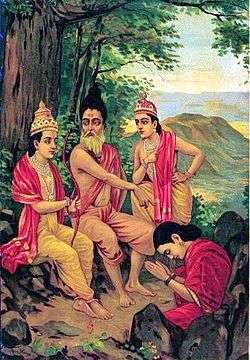 Brahma Rishi Vishva mitra calm sketch | |
| Religion | Hinduism |
| Children |
|
| Parents |
|
| Honors |
Rishi Rajarshi Maharishi Brahmarshi |
| Lineage | Kusha - Chandravamsha clan |
| Composed Mandala 3 of Rigveda, Gayatri Mantra, Ram Raksha Stotra | |
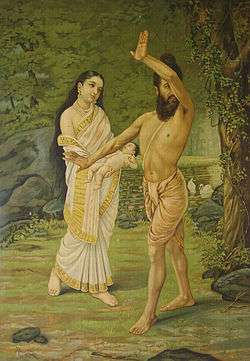
Brahmarshi Vishvamitra (viśvā-mitra) is one of the most venerated rishis or sages of ancient India. He is also credited as the author of most of Mandala 3 of the Rigveda, including Gayatri Mantra. The Puranas mention that only 24 rishis since antiquity have understood the whole meaning of—and thus wielded the whole power of—Gayatri Mantra. Vishvamitra is supposed to be the first, and Yajnavalkya the last.
The story of Vishvamitra is narrated in the Balakanda of Valmiki Ramayana.[9] Mahabharata adds that Vishvamitra's relationship with Menaka resulted in a daughter, Shakuntala, whose story is narrated in Adi Parva of Mahabharata.
Vishvamitra was a king in ancient India, also called Kaushika (descendant of Kusha) and belonged to Amavasu Dynasty. Vishwamitra was originally the Chandravanshi (Somavanshi) King of Kanyakubja. He was a valiant warrior and the great-grandson of a great king named Kusha. Valmiki Ramayana, prose 51 of Bala Kanda, starts with the story of Vishvamitra:
There was a king named Kusha (not to be confused with Kusha, son of Rama), a brainchild of Brahma and Kusha's son was the powerful and verily righteous Kushanabha. One who is highly renowned by the name Gaadhi was the son of Kushanabha and Gaadhi's son is this great-saint of great resplendence, Vishvamitra. Vishvamitra ruled the earth and this great-resplendent king ruled the kingdom for many thousands of years.[10]
His story also appears in various Puranas; however, with variations from Ramayana. Vishnu Purana and Harivamsha chapter 27 (dynasty of Amaavasu) of Mahabharata narrates the birth of Vishvamitra. According to Vishnu Purana,[11] Kushanabha married a damsel of Purukutsa dynasty (later called as Shatamarshana lineage - descendents of the Ikshvaku king Trasadasyu) and had a son by name Gaadhi, who had a daughter named Satyavati (not to be confused with the Satyavati of Mahabharata).
Satyavati was married to an old Brahmin known as Ruchika who was foremost among the race of Bhrigu. Ruchika desired a son having the qualities of a Brahmin and so he gave Satyavati a sacrificial offering (charu) which he had prepared to achieve this objective. He also gave Satyavati's mother another charu to make her conceive a son with the character of a Kshatriya at her request. But Satyavati's mother privately asked Satyavati to exchange her charu with her. This resulted in Satyavati's mother giving birth to Vishvamitra, son of a Kshatriya Gadhi with qualities of a Brahmin and Satyavati gave birth to Jamadagni, father of Parashurama, a Brahmin with qualities of a Kshatriya.
Names
Vishwamitra (Sanskrit: विश्वामित्र) is a Sanskrit word, meaning friend of the world. Other names for the sage include Kannada: ವಿಶ್ವಾಮಿತ್ರ; Malayalam: വിശ്വാമിത്രൻ; Telugu: విశ్వామిత్రుడు; Tamil: விசுவாமித்திரன் Vicuvāmittiraṉ; Thai: Swamit; Burmese: Bodaw; Javanese: Wiswamitra, Malay: Nila Purba.
Conflict with Vashista
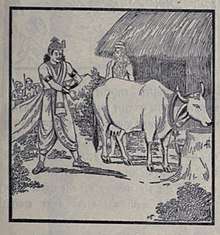
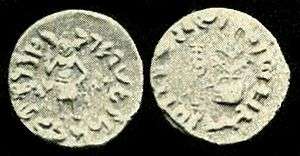
Obv: Standing figure, probably of Vishvamitra, Kharoshthi legend, around: Mahadevasa Dharaghoshasa/Odumbarisa "Great Lord King Dharaghosha/Prince of Audumabara", across: Viçvamitra "Vishvamitra".
Rev: Trident battle-axe, tree with railing, Brahmi legend identical in content to the obverse.[12]
In one encounter, Vishwamitra cursed the king Harishchandra to become a crane. Vashista accompanied him by becoming a bird himself. There were several such instances of violent encounter between the sages and at times, Brahma, god of creation, had to interfere.[13]
Alternative version
Vaśiștha destroys Vishvamitra's entire army by the simple use of his great mystic and spiritual powers, breathing the Om syllable. Vishvamitra then undertakes a tapasya for several years to please Shiva, who bestows upon him the knowledge of celestial weaponry. He proudly goes to Vaśiștha's ashram again and uses all kinds of powerful weapons to destroy Vaśiștha and his hermitage. He succeeded in the killings of Vaśiștha's thousand sons but not in the former.
An enraged Vaśiștha brings out his brahmadanda, a wooden stick imbued with the power of Brahma. It consumes Vishvamitra's most powerful weapons, including the brahmastra. Vaśiștha then attempts to attack Vishvamitra, but his anger is allayed by Devas. Vishvamitra is left humiliated while Vaśiștha restores his hermitage.[14][15]
Tapasya
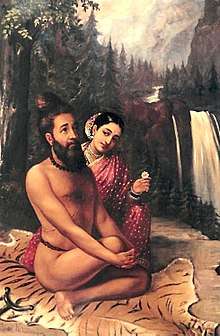
This incident made a deep impression on the King. He realized that power obtained by penances was far greater than mere physical might. He renounced his kingdom and began his quest to become a greater rishi than Vashista. He took on the name Vishvamitra. Vishvamitra faced many challenges in his life to become a Brahmarishi, before eventually giving up the greed to possess the cow.

After many trials and undergoing many austerities, Vishvamitra at last obtained the title of Brahmarishi from Vashista himself. During this time he had a daughter named Shakuntala(who appears in Mahabharata) with Menaka, an apsara in the court of Indra. Son of Shakuntala became a great emperor. He came to be known as Bharatha.
Alternative version
Kaushika seeks to attain the same spiritual power as Vashista, to become his equal, a brahmarishi. He undertakes a fierce penance for one thousand years, after which Brahma names him a Rajarishi or royal sage.
After another long penance of thousand years, Brahma names him a rishi, thus leaving his royal lineage permanently. And Brahma suggest him to take Bramharshi grade from his guru Vashista only as he only has the power to call you as Brahmarshi.

At this point, Indra, the king of Swarga attempts to test the tapasvi by sending Menaka, an apsara to seek Kaushik's hand in marriage. Kaushik then lives with Menaka for 10 years. They have a baby girl Shakuntala. Kaushik becomes angry when he realises Menaka's true agenda had destroyed his years of meditation and thus he cursed her that she will not possess her beauty, of which she was proud, in next birth.
Kaushika now goes to the banks of the river Kaushiki, which is the spirit of his own sister.

After many thousands of years of penance, Brahma names him maharishi, but also tells him that he has not become a jitendriya yet, lacking control over his passions. This is brought to light to Kaushika when he angrily curses Rambha, an apsara sent by Indra to foil Kaushika's plan again, to become a stone for 1000 years.
Rise to Brahmarishi
After cursing Rambha, Kaushika goes to the highest mountain of Himalayas to perform an even more severe tapasya for over 1000 years. He ceases to eat, and reduces his breathing to a bare minimum.
He is tested again by Indra, who comes as a poor Brahmin begging for food just as Kaushika is ready to break a fast of many years by eating some rice. Kaushika instantly gives his food away to Indra and resumes his meditation. Kaushika also finally masters his passions, refusing to be provoked by any of Indra's testing and seductive interferences.
At the penultimate culmination of a multi-thousand year journey, Kaushika's yogic power is at a peak. At this point, Brahma, as the head of Devas led by Indra, names Kaushika a Brahmarishi and names him Vishvamitra or Friend of All for his unlimited compassion. He then goes to meet Vashishta. It was customary that, if a sage was greeted by an equal or superior person, the sage would also greet the person. If the sage was greeted by an inferior person, the sage would simply bless them. Initially, when Vishwamitra greeted Vashishta with the pride of being a new Brahmarishi in heart, Vashishta simply blessed him. Suddenly all pride and desire left Vishwamitra's heart and he became a clean and clear brahmarishi. When Vishwamitra turned back to leave, Vashishta realised the change of heart and proceeded to greet Vishwamitra. Vishwamitra is also embraced by Vashista and their enmity is instantly ended.
Gayatri mantra
Vishvamitra is said to have found Gayatri Mantra. It is a verse from a sukta of Rigveda (Mandala 3.62.10). Gāyatrī is the name of the Vedic meter in which the verse is composed.
Gayatri mantra is repeated and cited very widely in Vedic literature[16] and praised in several well-known classical Hindu texts such as Manusmriti ("there is nothing greater than the Savitri (Gayatri) Mantra.", Manu II, 83),[17] Harivamsa[18] and Bhagavad Gita.[19][20] The mantra is an important part of the upanayana ceremony for young males in Hinduism and has long been recited by dvija men as part of their daily rituals. Modern Hindu reform movements spread the practice of the mantra to include women and all castes and its recitation is now widespread.[21][22]
Legends
Vishvamitra is featured in many legends and in different works of the Sanatana dharma.
Trisanku
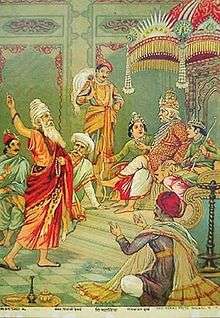
Another story Vishvamitra is known for is his creation of his own version of Svarga or heaven, called Trisanku Svarga.
When a proud King Trisanku asked his Guru Vashista to send him to heaven in his own body, guru responded that the body cannot ascend to heaven. King Trisanku then asked Vashista's hundred sons to send him to heaven. The sons, believing that Trisanku should not come to them after their father had refused, took outrage and cursed Trisanku to be a Chandala. Trisanku was transformed into a person with body smeared of ash, clothed in black and wearing iron jewelry. Unrecognizable to his subjects, he was driven out of the kingdom.
In his exile, Trisanku came across the sage Vishvamitra, who agreed to help him. Vishvamitra organized a great sacrifice and ritual propitiating the Devas, pleading that they accept Trisanku into heaven. Not one Deva responded. Angered, Vishvamitra used his yogic powers and ordered Trisanku to rise to heaven. Miraculously, Trisanku rose into the sky until he reached heaven, where he was pushed back down by Indra.
Enraged even more by this, Vishvamitra commenced the creation of another Universe (including another Brahma) for Trisanku. He had only completed the Universe when Brihaspati ordered him to stop. Trisanku, however, did not fully transcend through Trisanku Svarga created for him. He remained fixed and upside-down in the sky and was transformed into a constellation, which is now known as Crux.[23]
In the process of forming a new universe, Vishvamitra used up all the tapas he had gained from his austerities. Therefore, after the Trisanku episode, Vishvamitra had to start his prayers again to attain the status of a Brahmarshi and become an equal of Vashista.
Harishchandra/Ambarisha's sacrifice
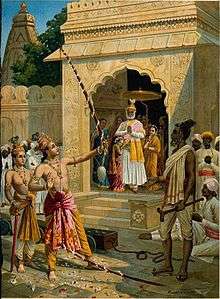
While undertaking a penance, Kaushika helps a boy named Shunashepa who has been sold by his parents to be sacrificed at Harishchandra/Ambarisha's yagna to please Varuna. The king's son Rohit does not want to be the one sacrificed, as was originally promised to Varuna, so young Sunashepa is taken. A devastated and terrified Sunashepa falls at the feet of Kaushika, who is deep in meditation and begs for his help.[24]
Kaushika teaches secret mantras to Sunashepa. The boy sings these mantras at the ceremony, is blessed by Indra and Varuna and Ambarisha's ceremony is completed.
In another version of the story, Sunahshepa is lost son of Vishvamitra. When Vishvamitra was Prince of Bharats (Kaushik) - and his name was Vishwarath then, he was abducted by the enemy king Shambar. There, Shambar's daughter, Ugra, falls in love with Vishvarath. Ugra convinces Prince Vishvarath to marry her. Looking at the good character of Vishvarath, Shambar also agrees for the marriage. Soon after the marriage, the Bharatas win the battle against Shambar. When theu found their Prince Vishvarath alive, they feel happy but they could not accept Ugra as their future queen as she is an Asura. To convert Ugra into an Aryan, Vishvarath creates Gayatri Mantra, but people still refuse to accept her. Soon she gives birth to a son, but to save the son from the angry people, the greatest female sage Lopamudra sends the child to a hidden place. To Lopamudra and Vishvarath's sadness, people kill Ugra. But the son is saved, without the knowledge of Vishvarath. This child grows young and he comes to sacrifice himself in the ceremony of Ambarisha (or King Harishchandra).[25]
In Ramayana
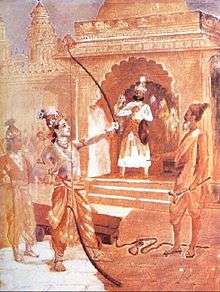
In the Indian epic Ramayana, Vishvamitra is the preceptor of Rama, prince of Ayodhya and seventh Avatar of Vishnu and his brother Lakshmana.
Vishvamitra gives them the knowledge of the Devastras or celestial weaponry [bala and adi bala], trains them in advanced religion and guides them to kill powerful demons like Tataka, Maricha and Subahu. He also leads them to the Swayamvara ceremony for princess Sita, who becomes wife of Rama.
Gotras
Brahmins belonging to Kaushika or Vishwamitra gotra are considered extremely oppressive and wrathful since they were descended from regal Kshatriya caste.[26][27]
In the case of Viswamitra, we have two Pravaras,[28]
- Kaushika
- Visvamitra
Vishvamitra gotra
People belonging to the Vishvamitra Gotra consider Brahmarishi Vishvamitra as their ancestor.
Kaushika gotra
Kausika was one of the names of Vishvamitra who was supposed to have lived in Mithila (presently in Nepal's Terai and India's Bihar) where his sister river Koshi still flows turbulently as she is said to be unmarried. Kaushika Gotra is one of the gotras of Brahmins and also of some Kshatriyas.[30] Vishwamitra adopted Devarata as his "eldest son",who became the head of the dynasty or Gotra called the Kaushiks.[31]
Worship
Brahmarishi Vishvamitra is worshipped in Sri Aabathsahayeswarar temple, Alangudi, Thanjavur, Tamil Nadu. The temple is estimated to be 1000–2000 years old.[32]
In film and television
- Vishwamitra is shown in Tamil movie Raja Rishi with Legendary Actor Sivaji Ganesan playing the role of the Sage.
- Vishvamitra is shown in Telugu Movie Brahmashri Vishwamitra.
- Vishwamitra is shown in the show Siya Ke Ram airing on Star Plus played by Manish Wadhwa.[33]
- The TV show Piya Albela is also based on the classic love story of Menaka and Vishwamitra depicted as a modern-day love story revolving around Naren and Pooja
See also
- Hindu mythology The first poetry on Vishwamitra in Hindi was written by Shahjad Singh Nikumbh who hails from royal family of Nikumbh rajputs
References
- ↑ Wilson, John (23 April 1877). "Indian Caste". Times of India Office – via Google Books.
- ↑ Bhishagratna, Kunjalal (1907). An English Translation of the Sushruta Samhita, based on Original Sanskrit Text. Calcutta. pp. ii(introduction).
- ↑ Bibek Debroy (2016). Harivamsha. Penguin UK.
- ↑ History Of Ancient India (a New Version) : From 7300 Bb To 4250 Bc,. Atlantic Publishers & Dist. 2006. p. 281.
- ↑ (India), Uttar Pradesh (23 April 1988). "Uttar Pradesh District Gazetteers: Farrukhabad". Government of Uttar Pradesh – via Google Books.
- ↑ Doniger, Wendy (23 April 1988). "Textual Sources for the Study of Hinduism". Manchester University Press – via Google Books.
- ↑ Jestice, Phyllis G. (2004). Holy People of the World: A Cross-cultural Encyclopedia. ABC-CLIO. p. 899.
- ↑ Nijhawan, A. (2009). Excusing the female dancer, South Asian Popular Culture, 7(2), pp 99-112
- ↑ "Valmiki Ramayana". Valmikiramayan.net. Retrieved 2013-03-26.
- ↑ A Classical Dictionary of Hindu Mythology and Religion, Geography, History, and Literature. Trübner & Company. 1870. p. 341.
- ↑ "Viśwamitra". Mythfolklore.net. 2007-10-16. Retrieved 2013-03-26.
- 1 2 Ancient India, from the earliest times to the first century, A.D by Rapson, E. J. p.154
- ↑ Wilkins, W.J. (2003). Hindu Mythology. New Delhi: D.K. Printworld (P) Limited. pp. 380–2. ISBN 81-246-0234-4.
- ↑ Paramahamsa Prajnanananda. Life And Values. Sai Towers Publishing. p. 113.
- ↑ Torchlight Publishing. A Prince in Exile: The Journey Begins. Jaico Publishing House.
- ↑ Bloomfield 1906, p. 392b.
- ↑ Dutt 2006, p. 51.
- ↑ Vedas 2003, p. 15–16.
- ↑ Rahman 2005, p. 300.
- ↑ Radhakrishnan 1994, p. 266.
- ↑ Rinehart 2004, p. 127.
- ↑ Lipner 1994, p. 53.
- ↑ "Crux – Trishanku". 30 January 2012.
- ↑ Pargiter, F.E. (1972) [1922]. Ancient Indian Historical Tradition, Delhi: Motilal Banarsidass, p.92.
- ↑ Munshi, K. M. (1933). Munshi Granthavali : 7. Ahmedabad: Gurjar Prakashan (for Bharatiya Vidhya Bhavan).
- ↑ Pande Bechan Sharma (2007). About Me. Penguin Books India. p. 33. ISBN 9780143101802.
- ↑ John Garrett. A Classical Dictionary of India: Illustrative of the Mythology, Philosophy, Literature, Antiquities, Arts, Manners, Customs &c. of the Hindus. Higginbotham and Company. p. 328. Retrieved 4 April 2014.
- ↑ John Brought. The Early Brahmanical System of Gotra and Pravara: A Translation of the Gotra-Pravara-Manjari of Purusottama-Pandita. Cambridge University Press. p. 149. ISBN 978-1-107-62398-9. Retrieved 26 September 2013.
- ↑ Prabhākara Mācave (1994). Hinduism: Its Contribution to Science and Civilisation. Machwe Prakashan. p. 65.
- ↑ Subodh Kapoor (2002). The Indian Encyclopaedia: Kamli-Kyouk Phyu. Genesis Publishing. p. 3935.
- ↑ Chander Kanta Suri. Vishwamitra, Parashuram, and Vasishtha. p. 43.
- ↑ "Sage Viswamitra,Dinamalr". Temple.dina,alar.com. Retrieved 23 April 2018.
- ↑ Just now. "Siya Ke Ram Latest Updates & Tweets - The Times of India". Timesofindia.indiatimes.com. Retrieved 2018-04-23.
.
| Wikimedia Commons has media related to Vishvamitra. |
.jpg)